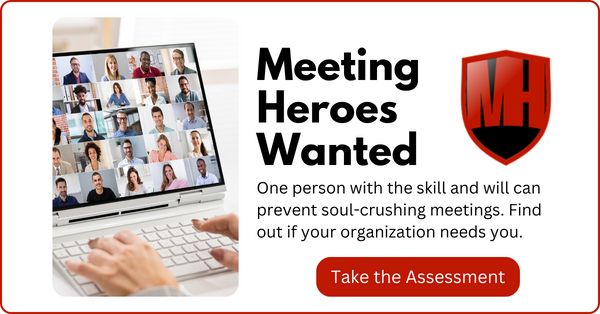Shorter meetings aren’t necessarily better, but in most cases they are. The sense of urgency can create energy and focus.
Time is money, right? Spend that time wisely. I can’t tell you the optimal time for a meeting, but I can give you a simple goal:
Zero Waste
When you invite a group to join you for your next meeting, remember that you are asking them to give you their time. Yours is valuable, but hey it’s yours to do what you want with.
Don’t steal time from others. Be respectful of your coworkers by making good use of their time.
Leading a shorter meeting isn’t that hard. Start with an intention and then build a plan.
Follow these 11 recommendations to run better meetings.
1. Be prepared
This idea appears to be common sense, and yet it is far from common practice. Everyone is so busy; they simply don’t have time to prepare.
Leaders don’t develop an agenda, and time is wasted arguing about the process the group should follow.
Participants don’t do their homework, and the meeting bogs down in guesswork and speculation.
Even the logistical preparation is often left undone, and time evaporates during the search for flipcharts, projectors, and extra chairs.
Preparation helps a group meet its goals quickly and effectively.
2. Start the meeting at an unusual time
The typical meeting is scheduled to start on the hour or half-hour.
This makes it easy for people to schedule back-to-back meetings. This also leads to chronic lateness as people grab a cup of coffee, stop at the restroom, or check voicemail between meetings. Time is wasted as participants wait for the latecomers.
A good strategy for overcoming this problem is to start the meeting at an unusual time. Try scheduling the meeting for 10:10 or 2:37.
The strangeness of the start time helps people arrive on time for two reasons. First they have time to take care of their needs between meetings. Second, they are more likely to notice the start time and think that the precision must be for an important reason. (It is.)
3. Make the meeting purpose clear and specific
It’s very difficult for a group to be quick in its work when it doesn’t know what it is supposed to accomplish. The group needs meaning and purpose and if these are absent, members will consume a tremendous amount of time in search of this direction.
A clear sense of direction energizes a group and keeps it focused. Little or no time is wasted pursuing work that isn’t relevant.
4. Schedule only the time you need
Suppose you are certain you could fulfill your meeting purpose in 50 minutes. Would you schedule a 50-minute meeting?
Most don’t. Instead they schedule it for an hour to build in a little cushion. And guess what happens? The work expands to fill the time allotted for it.
If you think you need 50 minutes, schedule 50 minutes. This will force you and the other participants to stay focused and move the meeting along as planned.
5. Use a meeting facilitator
Meetings often come to a screeching halt as the participants struggle to overcome some barrier. This is exactly when a facilitator can help.
A facilitator’s number one job is to prevent teams from becoming or remaining stuck. Facilitators offer a tool bag full of activities and techniques for quickly guiding a group over the rough spots with minimal pain and effort.
Yes, I’m a facilitator. Schedule a call to discuss an upcoming meeting.
6. Use a timekeeper
Meetings are expensive. Like any other expense, time consumed in meetings should be carefully managed.
Timekeepers track time for each agenda item. They warn the group when time is running out and stop the group at the end of the allotted time period.
The job appears simple; however, a good timekeeper must have the courage to interrupt a discussion when time has run out.
7. Don’t sit down
Although it appears gimmicky, it can be effective for routine informational meetings.
Think of a football huddle. The purpose of the huddle is very specific: Communicate the next play to everyone on the team. Imagine if the football team ran to the bench and sat down to get the next play. It would certainly slow the game’s progress.
Traveling to and from a conference room uses time. It’s not always necessary and for those times a huddle might be the perfect meeting solution.
8. Create a parking lot
In meetings a parking lot is a place to write down ideas, comments, and concerns that don’t fit the topic currently being discussed.
It’s an excellent tool because it captures potentially important ideas and keeps the meeting focused and on track.
9. Develop and honor time-related ground rules
Ground rules are the practices your group agrees to live by in its meetings. Here are some that might help a group better manage its time:
- We start on time.
- We never end late.
- We only tackle topics that we are prepared to handle.
- We stick to the agenda.
- We don’t meet without a clear purpose.
10. Divide and conquer the work
Groups often think each person needs to participate in each piece of the meeting. This just isn’t true.
Suppose you have a large meeting of 15 people and you want to evaluate the merits of three concepts.
Instead of having everyone evaluate each idea, break into three groups. Each group evaluates one concept and then reports its findings to the other groups. You’ll get better results in half the time.
11. Continuously improve your meetings
There is a management theory that states “What you measure improves.”
Measuring the length of your meetings will provide baseline information to help you see if you are improving. It’s a good start, but not enough.
You also need to think about how to improve your performance. Answering one question at the end of each meeting and applying the answers to future meetings can do this. “What could we have done to be more efficient in this meeting?”
Now shorten those meetings
The ideas in this article represent just a few of the many good ways to shorten a meeting. Conceptually, each of these ideas is quite simple. The tough part is finding the discipline and courage to use them.
When deciding whether or not to try them, it’s important to remember that you have nothing to lose, except for hours and hours of wasted time.




